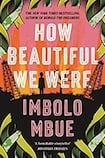
Behold the Dreamers was one of my favourite debuts of the last decade. Engaging storyline and effervescent dialogues made its author Imbolo Mbue a writer to watch out for.
Naturally then, I was eager to read her follow-up, more so since it seemed completely different from its predecessor. While Mbue’s debut was a compelling portrayal of an immigrant family’s struggle in a new land, How Beautiful We Were is set in the fictional African village of Kosawa which has been ravaged by a greedy US oil corporation.
The narration begins with a Greek chorus of Kosawa’s children – “When the sky began to pour acid and rivers began to turn green, we should have known our land would soon be dead”. For financial gain, the corrupt government has handed over the control of the village to Pexton, an oil company, sealing their fates. Pexton’s unsafe drilling practices have wreaked havoc on the environment. Dumping waste into Kosawa’s water supply and harmful industrial fumes have taken a serious toll on the health of the village’s residents. Years of consuming poisoned water and polluted air mean that children developed raspy coughs and rashes and life-long fevers. The chorus laments that “We remembered those who had died from diseases with neither names nor cures . . .”
Konga, the village’s madman, inadvertently sets in motion a revolution by stealing the car keys of Pexton’s representatives who are visiting to pacify the village people after the death of more children. While the village people are in awe of Konga’s courageous act of holding the men captive, one of the village leaders who also serves as a middle man warns them to that oppose the corporation in any form will cost them heavily. He cites soldiers burning down entire villages because of one man’s act of rebellion.
Bloody massacre
“We’ll pay the price if we don’t afford our friends here the respect we’re required to give them.” Inevitably, that is exactly what happens. This simple act results in a bloody massacre by government soldiers. However, news of this massacre reaches America through a sympathetic journalist’s report.
The parts narrated as a chorus by Thula, the story’s heroine, and her contemporaries collectively as “children” give us a heartbreaking insight into a childhood marred by toxic fumes, chronic illnesses and a high mortality rate. Thula’s narration effectively portrays a blighted childhood which became the new normal for her and her friends. She was not even a teenager when she witnessed the cataclysmic events of the 1980s. Grieving the loss of her beloved father in the conflict makes her even more determined to exact vengeance on the evil regime and Pexton. Early on in the book she remarks that “ I know nothing about how a girl makes men pay for their crimes, but I have the rest of my life to figure it out.” This she eventually does.
Thula, scarred but resolute, grows up to become a catalyst of change for her community. She arms herself with education, going to pursue higher education in America which she then brings home to fight against the corporation. While not exactly innovative, the vigour with which Mbue writes about this David vs Goliath situation makes us root for Thula.
Magical realism
There are frequent mentions of the village spirit and shades of magical realism throughout the story. Thula’s little brother Juba dies early on but is brought back to life through the mercy of the spirit. This miracle is also a factor that compels Thula’s father to join the ill-fated group of men to petition Pexton since he feels he owes the village’s spirit that gesture.
Mbue renders in poignant detail how trauma manifests differently for each individual. It makes Thula even more single-minded in her resolve to bring down Pexton but it haunts Juba all his life. Thula recounts how he always has a blankness in his eyes since the massacre. The chorus asserts this generational toll: “We couldn’t speak of the future without segueing into a lament for the bygone days of our ancestors . . .”
Through an array of voices, we get a multifaceted view of the many lives impacted by this environmental carnage. A downside of recounting the story from a multitude of perspectives is that it hampers the momentum. The reminiscing of various characters and abrupt jumps in the timeline result in a meandering plot which could have been more tautly edited. As it stands, this environmental saga is a stirring portrayal of the reverberations of the psychological and generational trauma endured by entire generations due to corporate greed.









